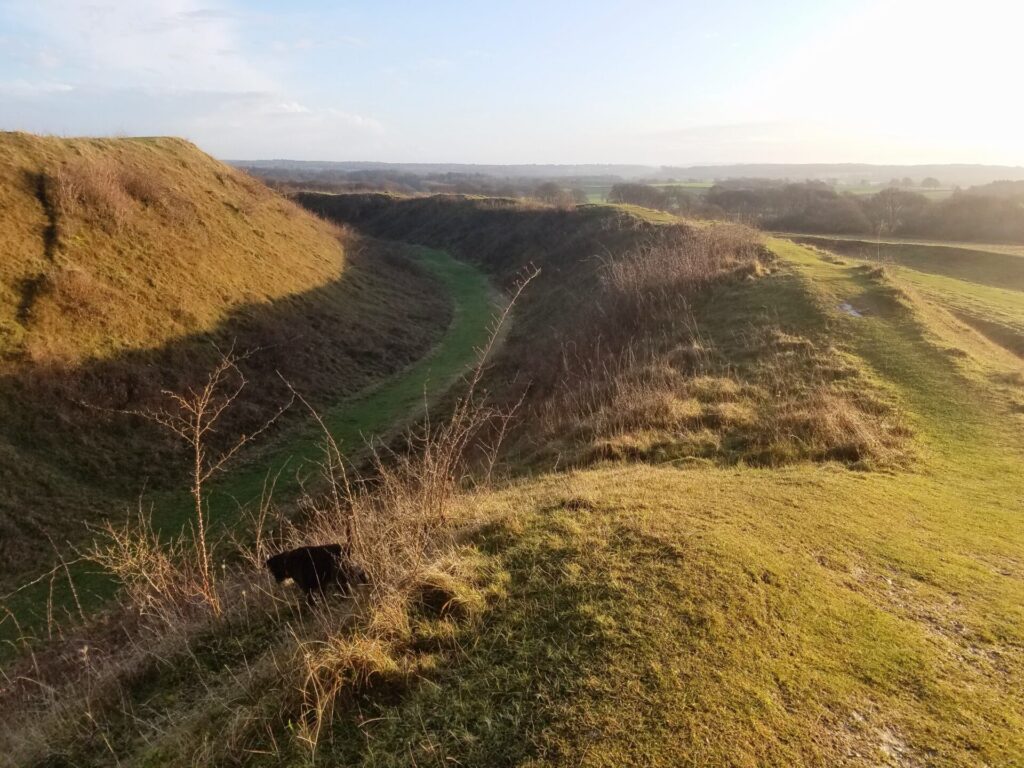North Dorset CPRE’s Rupert Hardy travels through the enigmatic past of the Iron Age fort and its mythical connection to King Arthur

Image: Rupert Hardy
Badbury Rings, the multivalliate Iron Age hill fort close to Wimborne, is one of the greatest ancient monuments in Dorset, and a favourite for family walks around its ramparts. However, not everyone is familiar with its fascinating history.
There is evidence of both Neolithic and Bronze Age settlements nearby, with bronze weapons found in close proximity. An intriguing find was the Badbury Stone, a large block of sandstone capping a barrow, excavated by 19th century antiquarians. Part of this sandstone was cut off as it had some strange markings, believed to be carvings of Bronze Age axes. The stone became known as the ‘Badbury Stone’ and was moved to the British Museum. The only other example of these carvings within the UK is at Stonehenge.
However, the hill fort was built by the Iron Age Durotriges tribe, who inhabited most of Dorset around 600-500BC.
The Roman conquest of Britain began in 43 AD and Badbury Rings was likely occupied by a legion under the command of the future emperor Vespasian. There is little evidence of a battle between the Romans and the Durotriges – a few ballista bolts were found at the site of the temple the Romans built there, but that is all. Probably the Durotriges did not see the merit of fighting a well-disciplined legion!
A mile from Badbury Rings, just outside Shapwick, the Romans built the town of Vindocladia, which became the second largest in the county after Dorchester. It was only discovered during the dry summer of 1976, when the outline of the Roman fort became apparent during the extended heatwave. Vindocladia was excavated in 2013, but has now been returned to farmland.
Badbury is reported to be haunted – in the 1970s, archaeological students fled their camp when they were disturbed by ‘the clash of metal, foreign voices and the sound of marching men’.
Battle of Mount Badon
The Rings were abandoned under the Romans, but re-occupied in the post-Roman period, as security declined with the departure of the last legions in 407 AD. The battle of Mount Badon was believed to have occurred around 500 AD between Celtic Britons and Anglo-Saxons, and it was first mentioned in a book by the 6th century monk, Gildas, who chronicled the agonies of the Britons after the Romans left.
It is very difficult to confirm anything during the Dark Ages, when so little was recorded, but Gildas credited the battle as a major and rare victory for the Britons, stopping the encroachment of the Anglo-Saxon kingdoms for at least a generation, possibly two. Later, King Arthur became a legendary figure, aided by Sir Thomas Malory and his book Le Morte d’Arthur, and then again in the 20th Century, thanks to Lerner and Loewe’s musical Camelot.
The identification of Badbury Rings with the Battle of Mount Badon was more recently reported in the 19th century by the eminent Dorset historian John Hutchins. Another historian, Roy Carr, suggested that the Saxons were held off from crossing Bokerley Dyke, further east, by the threat of an army in the west, perhaps stationed at Badbury Rings. Badbury is, however, one of three sites regularly suggested as the location of this battle, with sites near Bath, and another Badbury in Wiltshire, also recognised as contenders.
Who was Arthur?
The earliest text linking the Arthurian legend with Badon comes from the 9th century Nennius’s Historia Brittonum, which identifies Arthur as the British leader. Who was this Arthur in real life? Was he a Roman soldier – it is a Roman name – who stayed on to fight the Saxons after the Legions left? Gildas does not mention Arthur, but he concludes that Ambrosius Aurelianus, a late Roman leader who was the second son of the Emperor Constantine, was the key figure. Some historians suggest Arthur may have been Aurelianus’ son.

The legend
One legend suggests that the Saxons had been defeated further north and pledged to return home. Instead they broke their promise and landed at Torbay. They terrorised their way eastwards until they arrived at Mount Badon and built a fortified position. Arthur hurried south to give battle. Nennius says that Arthur killed 940 Saxons “by his hand alone” – some exaggeration surely. Malory’s Le Morte D’Arthur was a reworking of existing legends into tales about the legendary King Arthur, Guinevere and the Knights of the Round Table. It is highly probable there is a strong link between the historical and fictional figures. There is a legend that Arthur lives on as a raven in the woods covering the ancient citadel, and that a golden coffin is buried somewhere in the area.
On the mount
Of Badon I myself beheld the King
Charge at the head of all his Table Round,
And all his legions crying Christ and him,
And break them.
In his epic poem, Lancelot and Elaine, (above), Tennyson wrote about King Arthur and Badon, where Lancelot recounts how he fought with Arthur.
Did the battle occur here?
Frankly none of the three main contenders have exceptional claims, although it was clearly somewhere in south west England. In 2013 an archaeological dig was organised at Badbury Rings and late Roman artefacts were found, dating from AD 480-520, so the Rings were occupied at the right time: making it a plausible claim.
If you are proud to hail from Dorset, then take heart in the legend, take it as true and let your imagination take hold as you stroll across the ramparts!

